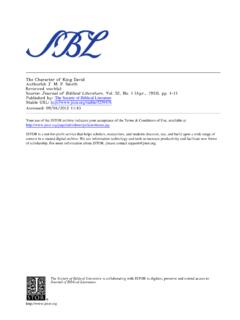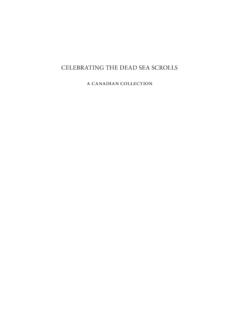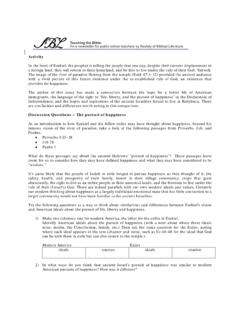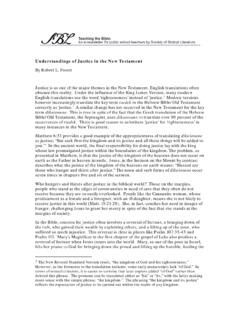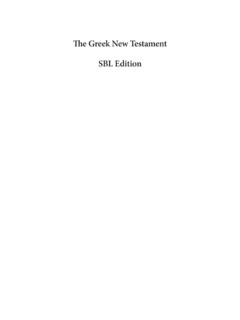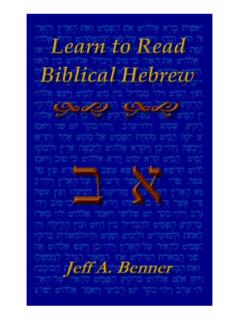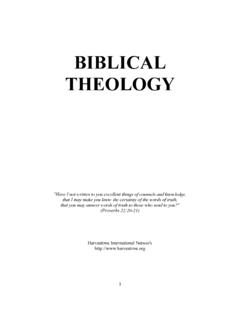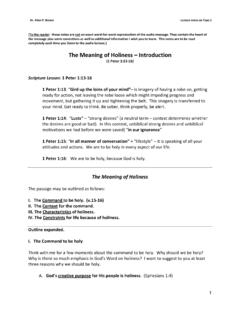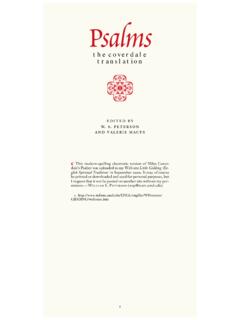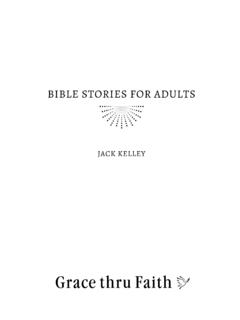Transcription of The Story of Joseph from Genesis - Society of Biblical ...
1 The Story of Joseph The Story of Joseph from Genesis Subject Area: English Language Arts Grades 9-10 Time Required: 1-2 class sessions General Topics: Plot, characterization, authorial structuring of texts, cumulative impact of word choices, explicit meanings and drawing inferences Average Grade Level from : SUMMARY This lesson plan focuses on the Story of Joseph and his family a Story that is found in the Biblical book of Genesis . The lesson asks students to engage in a literary analysis of the Story that will allow them to appreciate it as a work of high artistic quality. Specifically, they will pay close attention to the author s use of repetition and the presence of gaps in the plot to determine the impact these features have on how they read and interpret the Story . The lesson plan includes several worksheets designed to facilitate the development of skills such as identifying gaps and repetition in a Story , explaining how an author s use of repetition and gaps affects a reader s understanding of a Story , and analyzing characters roles in light of the presence of repetition and gaps in a Story .
2 The plan also includes a number of suggestions for extending this study, including comparing the Biblical Joseph Story to its counterpart in the Qur an, analyzing artistic representations of scenes from the Story , reading and comparing different English translations of the Story , and discussing the contemporary relevance of the Joseph Story . ALIGNMENT WITH GEORGIA STANDARDS OF EXCELLENCE Reading Literary: ELAGSE9-10RL1 Cite strong and thorough textual evidence to support analysis of what the text says explicitly as well as inferences drawn from the text. ELAGSE9-10RL3 Analyze how complex characters ( , those with multiple or conflicting motivations) develop over the course of a text, interact with other characters, and advance the plot or develop the theme. ELAGSE9-10RL4 Determine the meaning of words and phrases as they are used in the text, including figurative and connotative meanings; analyze the cumulative impact of specific word choices on meaning and tone ( , how the language evokes a sense of time and place; how it sets a formal or informal tone.)
3 ELAGSE9-10RL5 Analyze how an author s choices concerning how to structure a text, order events within it ( , parallel plots), and manipulate time ( , pacing, flashbacks) create such effects as mystery, tension or surprise. Reading Informational: ELAGSE9-10RI1 Cite strong and thorough textual evidence to support analysis of what the text says explicitly as well as inferences drawn from the text. ELAGSE9-10RI5 Analyze in detail how an author s ideas or claims are developed and refined by particular sentences, paragraphs or larger portions of a text ( , a section or chapter). LEARNING OBJECTIVES At the end of this lesson, students will be able to: identify the presence of gaps and repetition in a Story ; explain how a Story s use of repetition and gaps affects their understanding of it; and analyze the characters roles and articulate their evaluation of them in light of the gaps and repetition in the Story .
4 PRIMARY SOURCES QUOTES But when his brothers saw that their father loved him more than all his brothers, they hated him, and could not speak peaceably to him ( Genesis 37:4). Now Joseph was taken down to Egypt, and Potiphar, an officer of Pharaoh, the captain of the guard, an Egyptian, bought him from the Ishmaelites who had brought him down there ( Genesis 39:1). And Pharaoh said to Joseph , See, I have set you over all the land of Egypt ( Genesis 41:41). ARTWORK Govaert Flinck, Joseph in Prison Interpreting the Dreams of Pharaoh s Baker and Butler (Dutch, 1615-1660): 's-baker-and-butler-dutch-about-1639/ INTRODUCTION It is a rags-to-riches tale that has captivated numerous readers over the centuries, and it continues to resonate today because it addresses timeless themes and issues, such as parental favoritism, sibling rivalry, mistaken identity, sexual intrigue and revenge.
5 The Joseph Story recounts the adventures of a person who experiences both betrayal and reconciliation within his own family, and it does so in a way that illustrates how talented writers from the ancient world could be. The Story of Joseph is found in the first book of the Bible, Genesis . While Moses has traditionally been regarded as the author of Genesis , many scholars today would argue that ancient editors wove various materials into the book s present form some time after the Babylonian conquest of Jerusalem (587 ). Stretching over 13 chapters ( Genesis 37-50), the Joseph Story is one of the longest narratives in the Hebrew Bible/Old Testament. Often described as a novella, it functions as a bridge text that unites the traditions about the earlier Biblical patriarchs Abraham, Isaac, and Jacob ( Genesis 12-36) with the stories in the book of Exodus that explain how the Israelites escaped their bondage in Egypt and made their 40-year journey to the promised land of Canaan.
6 The section that immediately precedes the Joseph Story centers on his father Jacob, whose name is changed to Israel (32:28-29) and whose 12 sons are the eponymous ancestors of the 12 tribes (35:23-26). Many scholars believe the Joseph Story might have been an independent tradition that was attached to the stories about the patriarchs in order to explain how the Israelites got to Egypt, thereby setting the stage for the exodus under Moses leadership in the book that follows (see The Exodus Tradition in the Bible at ). It is also worth noting that the Story of Joseph is found in the 12th chapter of the Qur an, where it is the longest single narrative in Islam s sacred text. That version of the Story is treated in the Extending the Lesson section of this lesson plan. This lesson focuses on some of the literary features of selected portions of the Joseph Story ( Genesis 37 and 39-45) that help to make it such a memorable and enjoyable read.
7 In particular, we will look at the author s use of repetition and the presence of gaps in the plot. Through a close reading of the Story , students will come to appreciate the importance of these features and the impact they have on how they read and interpret stories. (This lesson does not include chapter 38 because its focus shifts from Joseph to other characters, Tamar and Judah. Because that Story does not directly advance the plot of the Joseph Story , many scholars believe that ancient editors of the Biblical materials inserted it at this point in Genesis .) This lesson requires that students have a basic understanding of the following: Terminology related to literature: author, plot, narrator, character, dialogue, setting, etc. How to analyze a literary text, especially in terms of what information is provided to and withheld from the reader How to compare two or more sections of a Story in order to identify common vocabulary, traits and themes within them GUIDING QUESTIONS How is repetition used in the Joseph Story ?
8 This includes repeated vocabulary, themes or patterns. Where do the Story s plot and character development seem to have gaps? This includes what the reader does not know regarding the details of the Story , the characters thoughts and motivations, and what characters do not know about other characters. What effect do repetition and gaps have on how one interprets a Story ? BACKGROUND Because of its status as a sacred text for many, students (and even teachers) sometimes find it strange or difficult to treat the Bible as they would any other book and study it as a work of literature. This lesson addresses that hesitancy by encouraging students to critically analyze a Biblical Story and thereby come to appreciate it as a literary work of high quality. Very few sections of the Bible are better suited to facilitate that task than the Joseph Story .
9 It is a coherent and cohesive narrative that was written by someone who was highly skilled in the craft of storytelling. For most scholars, the identity of the author, like that of those who composed much of the rest of the Bible, remains a mystery. Whatever its origin or authorship, its length and content make the Joseph Story an ideal text to explore how the Biblical writers made use of literary conventions like repetition and gaps to tell their stories. These two features are highlighted in this lesson because they are commonly found within Biblical narratives, yet they are often missed, ignored or misunderstood by readers. Repetition can take a variety of forms in the Bible, as it can in other literature words, phrases, motifs, themes and sequences of actions are sometimes repeated in order to call the reader s attention to certain aspects of the plot.
10 Similarly, different types of gaps are present throughout the Biblical writing. In some cases, details about something mentioned in the Story are left out, and elsewhere the reader is kept in the dark regarding the feelings or motivations of a character. This lack of information can be as important as what is explicitly stated in a text because it creates the ambiguity and tension that draw the reader into a Story . This type of analysis is important because it helps students to develop skills that are easily transferable and applicable to other literary works they will read. PREPARATION INSTRUCTIONS The Joseph Story could be the focus of one or two class sessions, depending on the teacher s preference. If it is to be the topic for a single session, the instructor will likely have to choose from among the various activities described below to determine which ones are most appropriate for the class.

